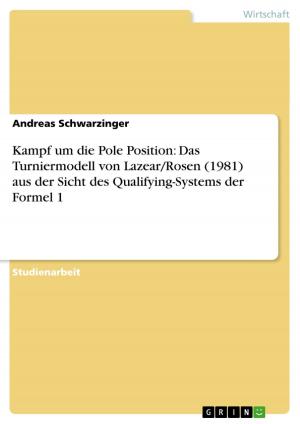Expressionism in Sean O'Casey's 'Juno and the Paycock' (1924)
Nonfiction, Entertainment, Theatre, Performing Arts| Author: | Sally Seifert | ISBN: | 9783668159198 |
| Publisher: | GRIN Verlag | Publication: | February 23, 2016 |
| Imprint: | GRIN Verlag | Language: | English |
| Author: | Sally Seifert |
| ISBN: | 9783668159198 |
| Publisher: | GRIN Verlag |
| Publication: | February 23, 2016 |
| Imprint: | GRIN Verlag |
| Language: | English |
Seminar paper from the year 2015 in the subject Theater Studies, Dance, grade: 1,0, Trinity College Dublin (Drama Department), course: Theater and Ireland, language: English, abstract: Having read the Dublin Trilogy consisting of 'The Shadow of a Gunman' (1923), 'Juno and the Paycock' (1924) and 'The Plough and the Stars' (1926), I understand that Irish history in the 1910's and 1920's was formative to the author Sean O'Casey. Firstly, the roots of expressionism, which can be found in Germany at the beginning of the 20th century, shall be outlined because they closely resemble the situation out of which O'Casey's work arises. Secondly, the characteristics of this rhetoric style are to be explained. Using 'Juno and the Paycock' as an object, the aforesaid characteristics are then to be analysed in context. In a final step, this research shall be summarised, hoping to prove that O'Casey's use of expressionism emphasises his general topic, the dangers of ideology, through subjectification. Just like many of his fellow playwrights O'Casey concerned himself with 'the [Irish] War of Independence, the [Irish] Civil War, the Easter Rising and World War One.' Unlike many however, O'Casey was especially interested in the Irish working class, being very much aware of the impact these political events had in every individual's reality. Whilst Lady Gregory and W.B. Yeats, for instance, propagandized Irish nationalism through plays such as 'Cathleen Ni Houlihan' (1902), O'Casey depicted the actual suffering caused. Yet, he thereby not only made use of realism, but also of expressionism, which is exactly what this essay shall be focussing on.
Seminar paper from the year 2015 in the subject Theater Studies, Dance, grade: 1,0, Trinity College Dublin (Drama Department), course: Theater and Ireland, language: English, abstract: Having read the Dublin Trilogy consisting of 'The Shadow of a Gunman' (1923), 'Juno and the Paycock' (1924) and 'The Plough and the Stars' (1926), I understand that Irish history in the 1910's and 1920's was formative to the author Sean O'Casey. Firstly, the roots of expressionism, which can be found in Germany at the beginning of the 20th century, shall be outlined because they closely resemble the situation out of which O'Casey's work arises. Secondly, the characteristics of this rhetoric style are to be explained. Using 'Juno and the Paycock' as an object, the aforesaid characteristics are then to be analysed in context. In a final step, this research shall be summarised, hoping to prove that O'Casey's use of expressionism emphasises his general topic, the dangers of ideology, through subjectification. Just like many of his fellow playwrights O'Casey concerned himself with 'the [Irish] War of Independence, the [Irish] Civil War, the Easter Rising and World War One.' Unlike many however, O'Casey was especially interested in the Irish working class, being very much aware of the impact these political events had in every individual's reality. Whilst Lady Gregory and W.B. Yeats, for instance, propagandized Irish nationalism through plays such as 'Cathleen Ni Houlihan' (1902), O'Casey depicted the actual suffering caused. Yet, he thereby not only made use of realism, but also of expressionism, which is exactly what this essay shall be focussing on.















